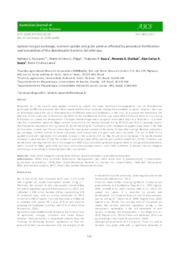Upland rice gas exchange, nutrient uptake and grain yield as affected by potassium fertilization and inoculation of the diazotrophic bacteria Serratia spp.
Upland rice gas exchange, nutrient uptake and grain yield as affected by potassium fertilization and inoculation of the diazotrophic bacteria Serratia spp.
Author(s): NASCENTE, A. S.; FILIPPI, M. C. C.; SOUSA, T. P.; CHAIBUB, A. A.; SOUZA, A. C. A.; LANNA, A. C.
Summary: Potassium (K) is the second most uptaken nutrient by upland rice crops. Beneficial microorganisms, such as Rhizobacteria participate in different processes that affect transformation of soil nutrients, making them available to plants. However, there are no information about the use of Rhizobacteria and different rates of K fertilization in this crop. To elucidate this interaction, the objective of this study was to determine the effect of the rhizobacteria Serratia spp. strain BRM 32114 and doses of K at sowing fertilization on upland rice development. The experimental design was a complete randomized block in a factorial 4 × 2 scheme with four replications, under no-tillage systems conducted in the Brazilian Cerrado during 2015/16 and 2016/17 growing season. The treatments consisted of four K2O doses (0, 20, 40 and 60 kg ha-1) without or with rhizobacteria applied three times in the field (on the seeds, sprayed over the soil, seven days after sowing and sprayed on the plants, 14 days after sowing). Biomass production, gas exchange, nutrient content in leaves and grain, yield components and grain yield were evaluated. The use of BRM 32114 applied in soil with high levels of K provided increase in the contents of P, Ca, Mg, Fe and Zn in rice leaves. The results showed enhances in plant biomass (7.2%), the number of panicles per plant (10%), and the grain yield of upland rice (16.3%). Therefore, our results allow inferring that the use of microorganism BRM 32114 provided significant improvements in rice growth/development, which resulted in higher grain yield over two consecutive growing seasons under field conditions. It showed that the bioagent Serratia spp. is promising to be incorporated into crop systems.
Publication year: 2019
Types of publication: Journal article
Unit: Embrapa Rice & Beans
Observation
Some of Embrapa's publications are published as ePub files. To read them, use or download one of the following free software options to your computer or mobile device. Android: Google Play Books; IOS: iBooks; Windows and Linux: Calibre.
Access other publications
Access the Agricultural Research Database (BDPA) to consult Embrapa's full library collection and records.
Visit Embrapa Bookstore to purchase books and other publications sold by Embrapa.

